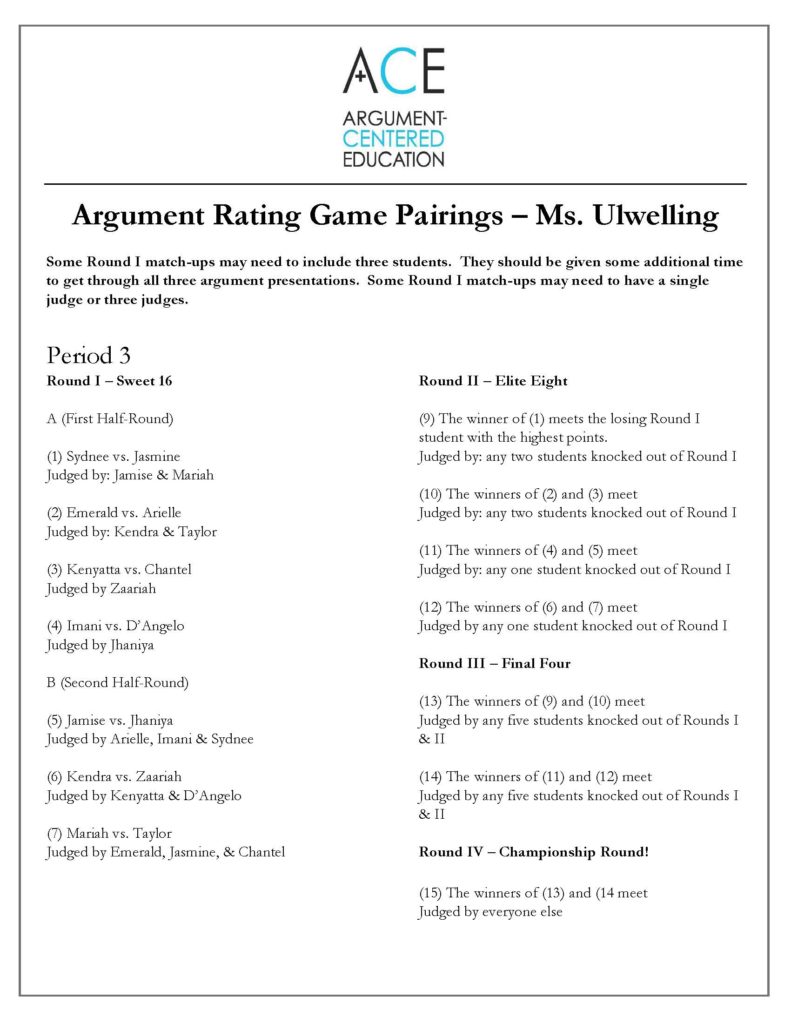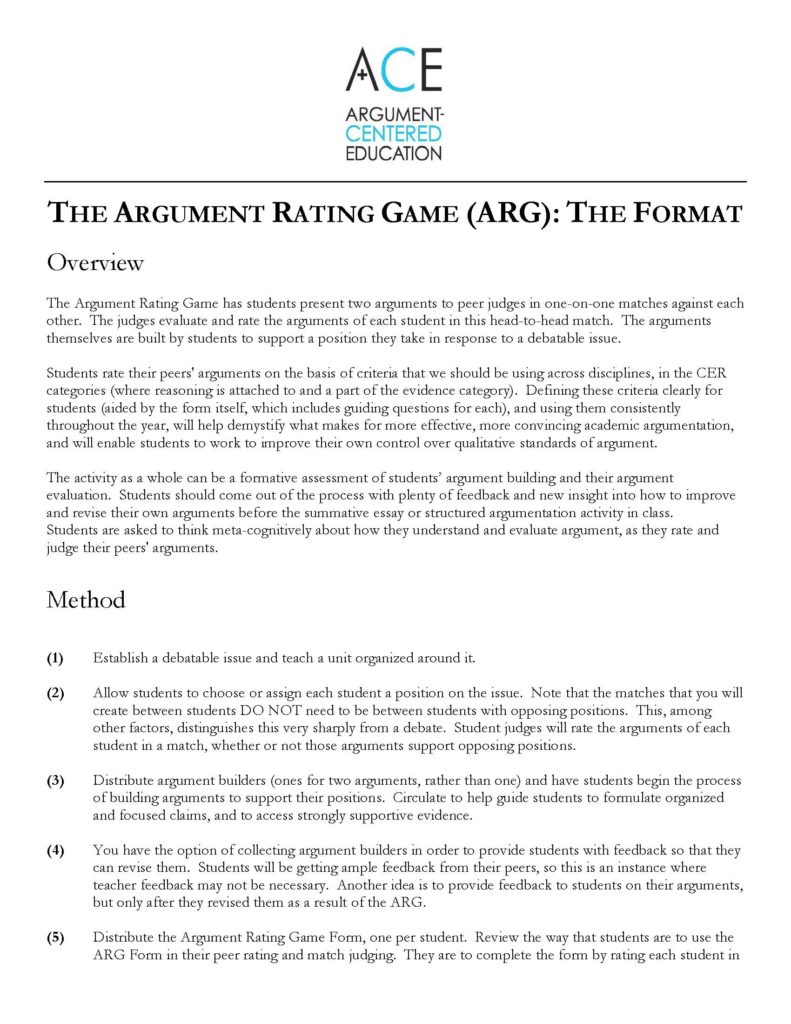
ARG, not Arrggghhhh!!
We have recently worked with a partner high school on a new gamified activity for heightening the effectiveness of peer rating of student’s academic argumentation, and helping students become more meta-cognitive about what makes their arguments more effective. The result is the Argument Rating Game (ARG).
Overview
The Argument Rating Game has students present two arguments to peer judges in one-on-one matches against each other. The judges evaluate and rate the arguments of each student in this head-to-head match. The arguments themselves are built by students to support a position they take in response to a debatable issue.
Students rate their peers’ arguments on the basis of criteria that we should be using across disciplines, in the CER categories (where reasoning is attached to and a part of the evidence category). Defining these criteria clearly for students (aided by the form itself, which includes guiding questions for each), and using them consistently throughout the year, will help demystify what makes for more effective, more convincing academic argumentation, and will enable students to work to improve their own control over qualitative standards of argument.
The activity as a whole can be a formative assessment of students’ argument building and their argument evaluation. Students should come out of the process with plenty of feedback and new insight into how to improve and revise their own arguments before the summative essay or structured argumentation activity in class.
Students are asked to think meta-cognitively about how they understand and evaluate argument, as they rate and judge their peers’ arguments.
Method
(1)
Establish a debatable issue and teach a unit organized around it.
(2)
Allow students to choose or assign each student a position on the issue. Note that the matches that you will create between students DO NOT need to be between students with opposing positions. This, among other factors, distinguishes this very sharply from a debate. Student judges will rate the arguments of each student in a match, whether or not those arguments support opposing positions.
(3)
Distribute argument builders (ones for two arguments, rather than one) and have students begin the process of building arguments to support their positions. Circulate to help guide students to formulate organized and focused claims, and to access strongly supportive evidence.
(4)
You have the option of collecting argument builders in order to provide students with feedback so that they can revise them. Students will be getting ample feedback from their peers, so this is an instance where teacher feedback may not be necessary. Another idea is to provide feedback to students on their arguments, but only after they revised them as a result of the ARG.
(5)
Distribute the Argument Rating Game Form, one per student. Review the way that students are to use the ARG Form in their peer rating and match judging. They are to complete the form by rating each student in a match they are judging based on the eight criteria for effective argumentative claims and evidence use on the form itself, and in general use in argument-centered instruction.

(6)
Review in detail what each criterion means and the guiding questions on the form to help students identify and evaluate how well the criterion is met by each students’ argumentation. Note that the form asks students to rate each student on their two arguments together. That is, a student gets one rating for each criteria, not two ratings, even though the student is presenting two arguments. Also, impress upon students how important it is to rate and evaluate the argumentation on each criterion separately and individually. They should avoid generalizing about the quality of the argumentative claims or the quality of the evidence and filling in the same rating for each of the four criteria for these components, respectively. Each criterion is isolating a separate quality of argumentation, and it is very possible, even likely, that a student will have evidence that rates higher on one criterion than another in their use of evidence, for example. Also, make it clear to students that they have to judge matches as objectively as possible. Students are remarkably good at this, in most instances.
(7)
Distribute the pairings for Round I and for subsequent Rounds of the ARG. Review how the pairings work with students. Note that Round I is divided into an A half-round and a B half-round. This is because all students in the class are participating in this round, so only half can participate in each half-round, while the other half judge.

(8)
Structurally, the Argument Rating Game is organized into four rounds, where the opening round has either eight rounds (the Sweet Sixteen) or twelve rounds (the Starting 24), the second-round pairs the winners of the opening round (Elite Eight or Trending Twelve), winners of that round moving on the Final Four or Select Six, and ending with a Championship Round of either the top two or three students. Each round is judged and rated by an increasing number of peers.
(9)
A round is made up of three five-minute segments. You should time and moderate these segments – meaning you should announce to the class when they begin and end and when the round as a whole has ended. The segments are:
Student 1 presents/Q & A to Student 1 — 5 Minutes
Student 2 presents/Q & A to Student 2 — 5 Minutes
Judges reflect and rate/Announcement of result — 5 Minute
The winner of a round is the student with the most judge votes. If the votes are a tie, the winner is the student with more total rating points than the other student. If rating points are also tied, you should quickly look over both argument builders and determine a winner.
(10)
As rounds progress, students can revise their argument builders (quickly, expediently) in any way that wish to, making them more competitive and stronger for the next round. Of course, the likelihood is that they will be presenting largely the same arguments throughout the game. That is OK. They can and should revise at the conclusion of the game. Also, you can de-brief and discuss arguments after either or both of the final two rounds, with the full class.


